Loitering munitions are now central to the United States (US) and the Russian militaries for their respective theaters in the western Pacific and eastern Europe, according to its military leaders.
Private Military Company (PMC) Wagner chief Yevgeny Prigozhin and US Marine Corps Commandant General David Berger have found a common solution in kamikaze Unmanned Aerial Vehicles (UAV) to overcome the particular techno-military challenges they face.
Prigozhin was quoted in a few Russia-friendly Telegram groups, which paraphrased him as saying that it was essential to mass produce “shock drones” for more “effective counter-battery combat” against Ukrainian artillery.
While Prigozhin’s statement could not be independently verified, parallel developments in Russia where the government has pushed a massive effort to become a drone power – formal industrial and technology policies, dozens of seminars, industry-academia meets, and setting up specialized manufacturing zones – lends credence to the claim.
Berger meanwhile wants to overcome China’s massive numerical and logistical superiority in the western Pacific by using “attack drones” from US Navy warships to hit Chinese naval vessels in a Taiwan crisis.
The UAVs, he said, could be used in conjunction with anti-ship missiles (AShM), suggesting a decoying tactic to engage and distract enemy air defenses and sensors.
US & Russia Need Kamikaze Drones Against China & Ukraine
Speaking at the Marine Barracks in Washington DC., Berger said the USMC would consider expanding the use of loitering munitions in the Indo-Pacific. The drones have less explosive force and speed but are easy to deploy and do not need elaborate logistics for transport and storage.
This is expensive, time-consuming, and risky since adversaries could always target logistic supply lines to degrade one’s long-term fighting potential.
This precise scenario is playing out in Ukraine, where Russia’s long-range gun and rocket artillery briefly lost its advantage when Ukraine targeted the supply lines that fed the weapons in November. This forced Russia to withdraw to the west side of the Dnieper River in Kherson in November last year.
Against China’s long-range anti-access/area-denial missiles that US military leaders admit threaten the US military, its away disadvantage is another drawback. US Marine Corps Assistant Commandant General Eric Smith admitted this last year in an online interview with the Stimson Center.

While the US has conceived a ‘swarm of swarm’ concept where groups of drones control several other drones and hypersonic and ballistic missiles as a part of its counter-A2/AD plan, both have their drawbacks.
Autonomous drone swarm control technology is yet to mature, while hypersonic missiles are prohibitively expensive, with a poor cost-benefit ratio.
“I think, in the coming years, both the US and the (Japanese) Self-Defense Forces will look for how to use that capability in ways that we haven’t used it so far,” Berger said. In a cross-strait crisis, the Chinese military could cut off Taiwan’s access to eastern sea routes, or Chinese forces could attempt to enter the Pacific by crossing the ‘first island chain’ of Okinawa, Taiwan, and the Philippines.
“Attack drones, in combination with anti-ship missiles, are expected to be effective in putting a stop to China’s naval mission in such scenarios,” the Nikkei Asia report added.

Loitering Munitions Are Less Destructive, Yet Effective
In Ukraine, kamikaze drones like the Russian Lancet-3 have seen dramatic fame after dozens of videos showed them striking Ukrainian bunkers, artillery, tanks, heavy vehicles, radars, surface-to-air missiles (SAM), and missile boats.
Russia rapidly increased its use after the Kherson withdrawal, minimizing the use of vulnerable supply lines. However, the same problem afflicts kamikaze drones in Ukraine as it would on the high seas against China – poor destructive capability.
A loitering munition cannot sink a warship but can only disable it. In Ukraine, too, several videos show Ukrainian self-propelled artillery and tanks being largely intact despite being hit by Lancets. But the “success largely depends on the accuracy of the hit.
On one of the frames, the Lancet enters the area of the ammunition storage compartment, which leads to the withdrawal of the howitzer from action,” said a post by the defense analysis website, Rybar on its Telegram channel.
But for towed artillery and multiple-launch rocket systems, kamikaze drones can permanently disable and possibly destroy them since they are exposed without armor protection. Russian defense bloggers have called for “further arming units with similar kamikaze drones and their modernization to conduct counter-battery combat more effectively.”
Artillery Shells Will Be Used Rapidly
Their warning about the high artillery shell usage rate is something both Ukraine and NATO countries have been experiencing since last year.
Ukraine has been burning through thousands of shells daily, causing a massive ammunition shortage among European and US militaries since they have had to supply Kyiv from their stockpiles.
The US has been running critically low stocks of 155mm rounds since August 2022. Its defense industry can manufacture only 11,000 rounds a month, which Ukraine sometimes fires in just over a few days.
There is no reason why such a situation might not afflict Russia too. “There will be a shortage of shells until we mass-produce shock drones.
They will be able to take out the artillery and air defense of the enemy. After that, the need for shells will drop significantly,” said a comment on another Telegram group.
The kind of industrial wherewithal where weapons could be endlessly manufactured daily for tens of thousands of soldiers was during World War 2, under the Stalinist industrial model. It is difficult to see how the peacetime Russian industry can meet the demand.
- The author can be reached at satamp@gmail.com
- Follow EurAsian Times on Google News




